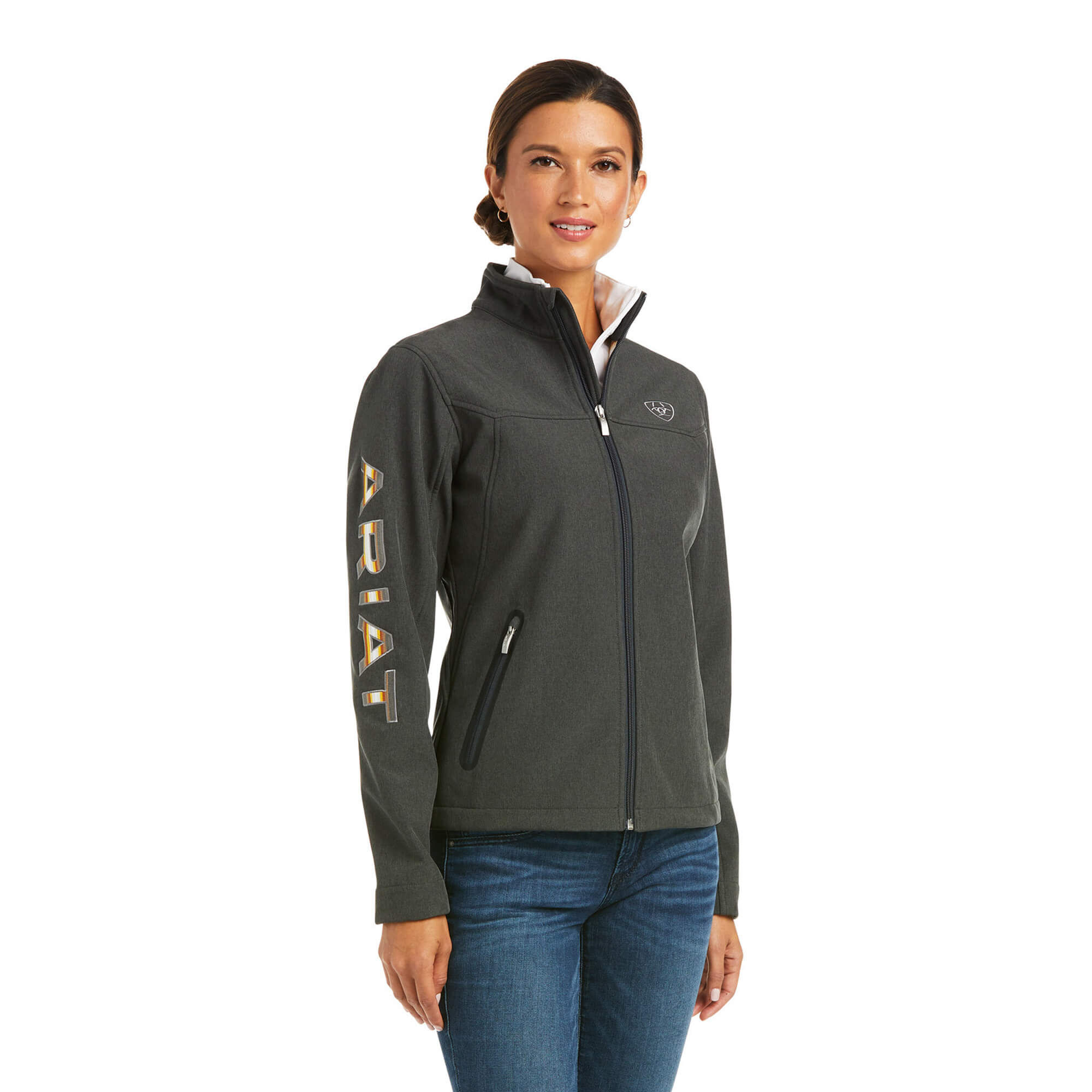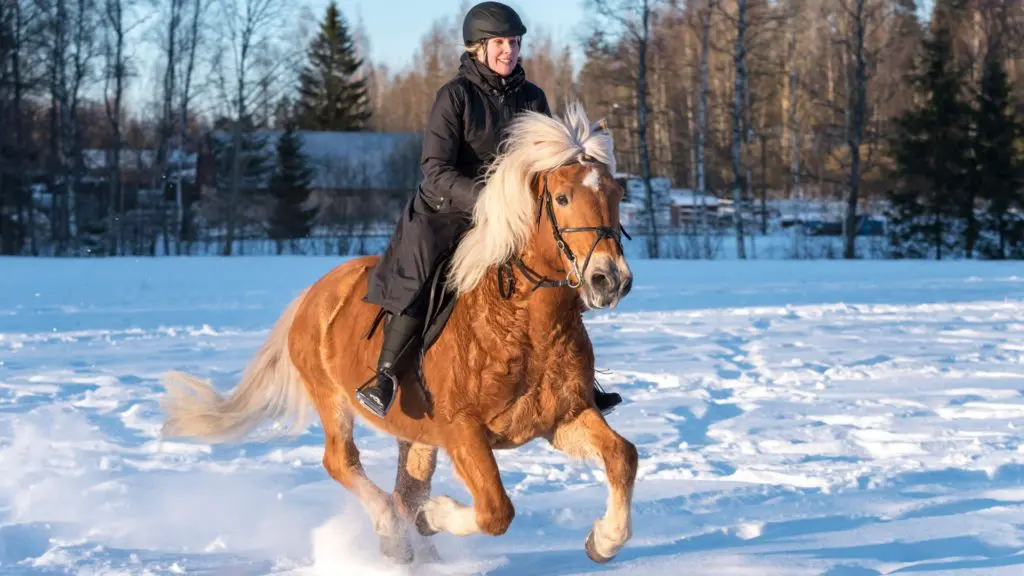Last updated: March 21, 2023
We typically take a multiday horseback ride during the winter holidays. This year it’s freezing, making it essential we prepare for the unique challenges presented by the cold temperatures, ice, and snow. So I researched what we need to keep our horses and ourselves warm and safe.
When horseback riding during cold and snowy seasons, wear suitable gloves and boots, dress warm, layering your clothes is best, don’t push your horse too hard, and ensure it has shoes with a good grip.
Horseback riding down wooded trails in the winter is beautiful. But you and your horse need to be prepared for the ride so you can enjoy it safely.
Tips for horseback riding in the cold.
The scene is in West Virginia on a small farm. Three children, ages ten, twelve, and fourteen, are standing in the cold, it is a few days before Christmas, and snow is in the air.
They are warmly dressed but curious about why they are standing outside in the cold. Then the pickup truck arrives and riding in the bed is a horse. The horse is a Christmas present for the middle girl.
She is wearing rubber boots, thick pants, a sweater, and her father’s lined leather winter coat. She spends the next two hours outside, staring at her horse in wonder.
Her mother has to make her come inside; she would gladly have eaten and slept outside with her new horse. Why is that story important to the question about riding and horse care in cold weather?
Part of it is how the children were dressed. I was the oldest; I can tell you that I had long underwear, a t-shirt, a sweater, and a coat. I wore jeans over the long underwear, two pairs of socks and the same type of boots. I was still cold, mostly because I was standing still.

Clothing for winter horseback riding.
Some things have improved over the decades since that story occurred. Warmer clothing choices are available to some degree, or at least the warmer stuff is more affordable and lighter.
However, the outfit would essentially be the same except for proper riding footgear. A scarf comes in handy to keep the cold breeze from chilling ears and throat, and gloves are definitely in order.
Another key is to layer your clothing. Often mornings are frigid, and temperatures rise mid-day, so it’s helpful to have outerwear you can remove and put back on as the weather changes.

Jackets for winter horseback riding
Horseback riding is a great way to enjoy the outdoors during winter. However, it’s important to dress properly for the weather conditions. A horse riding jacket is a must-have piece of equipment for any rider who plans to spend any significant amount of time in the saddle during the cold weather.
Horse riding jackets are specifically designed to keep riders warm and dry, even when the temperature drops to freezing. They are usually made from waterproof or water-resistant materials, and they often have insulated linings to provide an extra layer of warmth.
In addition, horse riding jackets often have special features like zip-up front pockets and hoods that can be pulled up to protect the rider’s head from the wind and rain. I wear a lightweight jacket with layers underneath so that if it warms up, I remove some clothes, allowing me to stay comfortable.
If you are in the market for a new riding jacket, I suggest you check out my review of the Ariat Pendalton fleece jackets; they are comfortable and lightweight.
Gloves
Gloves are actually one of the significant improvements; you can have warm hands and still be able to feel the reins or tack the horse. In fact, chemical hand and foot warmers can be placed inside the gloves or in the boots to keep those critical appendages comfortable.
For stable mucking, other work gloves will work better than the hand-crocheted gloves we often use for riding purposes. Here are my top four winter gloves on Amazon.

Helmet covers
Let’s face it; riding helmets are a necessity, but they are not warm. Exposed ears can make winter riding excruciating at best, resulting in injury to the ears at worst.
It would be difficult and somewhat dangerous to wear a helmet over a hat but worry not. You can get helmet covers that go over the helmet and protect both throat and ears from the cold.
Amazon has an excellent selection of helmet covers you can find here.
Socks
During the nineteen seventies, there was this new sensation called toe socks. These are and were the most uncomfortable socks ever put on the market. One would think; with each toe encased in a “finger,” it would be warmer.
Nope, each toe froze individually. However, socks are essential in cold weather. They provide insulation and help keep your feet warm. Wool is considered one of the warmest products for socks.
Even with modern technology, the best socks still use some wool. A blend can be more comfortable; wool can be very itchy. However, you can wear sock liners under wool socks to get the best wool characteristics without discomfort.
Thermal underwear:
When it’s cold, this is a must-have. One might think of wool for this, but that isn’t the best choice. Even in the cold, we can sometimes work up a sweat. It’s crucial to have a way to wick that moisture away from the body and dry it quickly. Otherwise, you will be wet and cold, especially when your activity level lowers.
Cotton or cotton/silk blends are amongst the best for this. Hemp is also a good choice. For those concerned about its relationship to marijuana, don’t worry.
Hemp has little to no THC and was legalized for use in clothing and other manufacturing products in 2016. It is breathable, soft, and fulfills the needs of thermal underwear. It’s also soft and gets softer after each washing.
Winter riding boots
Winter riding boots should keep your feet warm and dry. They must also have a heel to prevent your foot from sliding through the saddle’s stirrup and be comfortable.
Some winter boots are bulky and won’t fit most stirrups; you should avoid these. Always read customer reviews before ordering a pair online. Ariat is a good brand, but Mountain Horse specializes in winter riding boots and is the top choice for most equestrians.

Preparing your horse for winter riding.
Riding blankets
Winter riding blankets, rugs, and quarter sheets are basically the same thing. They can be used when riding your horse to protect against rain or cold weather. Cold weather rugs are made of either synthetic fleece or wool.
The riding blanket covers the horse’s hindquarters and keeps it warm during cold-weather rides. You can easily remove it after your horse warms up or put it on after your ride.
To rug or not to rug; that is a good question. However, a fleece blanket is handy to help the horse stay warm when riding. But the decision to use a heavy blanket is individual to both horse and rider.
Some horses don’t like blankets of any sort, even when being ridden in the winter. And some riders find it difficult to tack up a horse with a blanket in place. Horses, for their part, typically enjoy cooler weather and get enough warmth from the saddle and exercise of the ride.
However, some horses need added protection against the cold, and a winter blanket is necessary. If you think your horse needs one, Amazon offers a wide variety of winter blankets.
Horse hoods and neck warmers
A horse’s neck is very long, and any animal’s head is where a lot of body heat is lost. A horse hoodie helps keep that vital area warm enough in super cold weather. It is better to be a slightly silly-looking warm horse than to cope with frostbite or other ill effects of cold weather.
Below is a helpful YouTube video that reviews winter riding gear.
Horse boots and wraps
Polo wraps and hoof boots are available and, in some cases, might be a consideration. Although it will take some work to figure out which type to use for your purpose, wraps are useful to protect your horse’s lower legs.
Horses have thin skin covering their lower legs, and it can take a long time to heal if there is a cut, and ice is known for its ability to cut deeply.
Hoof boots come in various styles, and some are made with significant grip, which is suitable for walking on ice and snow.
Winter horseshoes
If you look at a horseshoe, you may notice that in the summer, they are smooth. In parts of the country, they’re smooth all year round; there’s little to no ice showing up in the United States’ southern regions.
However, if you plan on riding in the winter, you may want to consider horseshoes designed for winter riding. If you’ve ever tried to walk on ice in leather-soled shoes, you’ll know that it is a surefire way to have a nasty fall.
At best, you will learn how to ski on shoes as you will slide all over the place. Horseshoes need the same thing that we do, something that grips when walking on ice. Talk to your farrier; they will know what to do.
